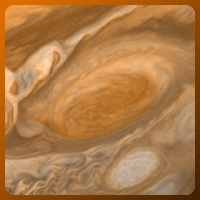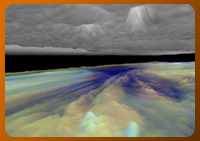You are seeing this message because you are using an out-of-date browser.
Please click here for more information.

Image courtesy of: JPL/Galileo Mission
Since Jupiter is a gas planet, it is actually all clouds made up mostly of hydrogen and helium. The "clouds" that we see that make up the colored bands and spots are on the very topmost layers of the giant planet. Any planet's atmosphere, even that of Earth, is like an ocean of gas. Like any ocean, an atmosphere has currents and these currents are what cause wind here on Earth and the swirls in Jupiter's clouds that you see in the picture at right.
The different colors in Jupiter's clouds are still something of a mystery even with with all the information we have from the Galileo and Voyager missions. Scientists believe that they are made up of combinations of sulfur and phosphorus, but it is still very much a mystery as to how the color patterns keep changing. Although the "winds" on the planet are moving at several hundred miles an hour, we aren't sure whether the winds are caused by the planet's high rotation speed or from internal heating or some combination of the two.
Perhaps the long term study of the data returned by the Galileo mission will provide more answers to some of these questions. The answers may only come with future missions to the planet. Only time will tell for sure. In the meantime, we can just appreciate the beauty of the planet.

Image courtesy of: JPL/Voyager Mission
Like a giant, colorful, mysterious hurricane, the Great Red Spot has been raging away on Jupiter for at least the last 350 years. It was first observed in 1655 by the French astonomer Jean-Dominique Cassini. When viewed through a telescope, in in a picture like the one at right, you may first believe that the spot isn't all that large. This is because Jupiter is so huge. The Great Red Spot is large enough to contain three Earths, and shows no signs of getting smaller anytime soon.
Even with all the information that the Galileo and Voyager missions have sent back to Earth, the spot is still very much a mystery to us. It acts like a hurricane, but no hurricane on Earth has lasted so long. We aren't even completely sure what elements make up the colors of the Red Spot, although some combination of phosphorus seems to be the best bet. The Great Red Spot is still another mystery that time and research will solve for us.

Image courtesy of: JPL/Galileo Mission
Among the things that we do know about Jupiter's atmosphere is that it actually has lightning much like thunderstorms here on Earth. When the Galileo mission arrived at Jupiter, one fo the first things it did was to drop a small package of instruments, called a probe, into the planet's atmosphere. The information the probe sent back allowed scientists to construct the three- dimensional image of the cloud layers shown at right. Unfortunately, the spot where the probe was dropped turned out to be very quiet, so we weren't able to learn more about Jupiter's lightning, but scientists were able to determine that there are three distinct layers of clouds, each being made up of different materials.
The topmost, or highest, cloud layer is made up mostly of ammonia ice clouds. The next layer's clouds are made of a combination of ammonia and hydrogen sulfide, while the lowest cloud layer is made up of water ice, with a little liquid water. There isn't liquid water in the form of oceans like we have here on Earth, but there is some water. The Galileo probe told us that there wasn't as much water as expected, but that have been the result of where the probe entered Jupiter's atmosphere.

